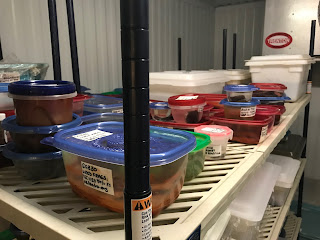 |
| Sheaves used in rigging blocks on USS Monitor |
 |
| Thousands of artifacts are in plastic containers |
 |
| Turret inside giant conservation tank (All photos by the Picket) |
The anniversary “Battle of Hampton Roads Weekend” event beginning Friday at the Mariners’ Museum and Park in Newport News, Va., will include behind-the-scenes tours of the laboratory that is conserving giant and tiny artifacts from the USS Monitor.
I got a look
inside the USS Monitor Center’s Batten Conservation Complex during a visit last
week. While I don’t know precisely what the $10 tours of the center and lab this weekend will
include, I wanted to share some photos from my walk-through with conservation
administrator Tina Gutshall. I also spoke with project manager Will Hoffman.
The ironclads
USS Monitor and CSS Virginia are famous for their March 9, 1862, clash that changed
naval warfare. While the Confederate vessel was scuttled and largely lost,
conservators and historians for nearly two decades have studied remnants of the
Monitor that were recovered off Cape Hatteras, N.C., where it was lost in a
storm.
Signature
pieces receiving conservation treatment in tanks at the lab are the ship’s huge
turret, the engine and condenser, and two 11-inch Dahlgren guns. Thousands of smaller items are being conserved in plastic containers filled with water or chemicals.
Hundreds of treated artifacts are displayed in the museum, including the propeller and anchor.
Gutshall told me the goal is to have the conservation completed by 2029-30. But that’s somewhat of a best estimate.
“It has always been fluid because you do what is best for the object,” Gutshall said.
 |
| Organic materials are kept in a special cooler |
 |
| Hoffman and Gutshall on walkway above tanks |
Gutshall told me the goal is to have the conservation completed by 2029-30. But that’s somewhat of a best estimate.
“It has always been fluid because you do what is best for the object,” Gutshall said.
The chief
challenge for Hoffman and his team is finding and utilizing – or in some cases, tweaking --
the appropriate technology to treat a particular item. Cast iron and wrought
iron have different properties, so while dry ice cleaning might work for one
object, it may not for another. Hundreds of artifacts have been treated with dry
ice, which has the effectiveness of sand blasting.
“We have to figure out every step of it,”
Hoffman told me. “We have to understand how (an item) was made, how it was used
and how it deteriorated.”
The conservation process largely concentrates on removing sea
salts that permeated the iron for about 140 years. Over 15 years, conservators
have made significant process on the turret, but fine corrosion is embedded in folds
of the curved iron plates.
 |
| One of the 11-inch Dahlgrens |
 |
| The Monitor's engine receives treatment |
John Ericsson, who built the USS Monitor, utilized an innovative engine that is made of many materials.
“We have the earliest and most complete steam
engine room in the world,” said Hoffman, referring to the engine, condenser, bulkhead,
propeller and its shaft, two Worthington pumps and the reversing gear.
Conservators also are concentrating on gun carriages for the
Dahlgrens that fired from the turret. One has been disassembled; the other is
still in a tank. They are made of iron, copper alloy and wood. The preferred treatment for a composite artifact is to take it apart so that each piece can be
treated.
 |
| Reproduction of a Worthington pump |
 |
| One of the new cabinets installed in laboratory. |
 |
| Some of the gaskets used on Monitor (All photos by the Picket) |
Gutshall also helps students and researchers with questions about the USS Monitor, including its design and construction.
Hoffman admired the craftsmanship that went into
the ironclad, which was built in less than four months.





No comments:
Post a Comment